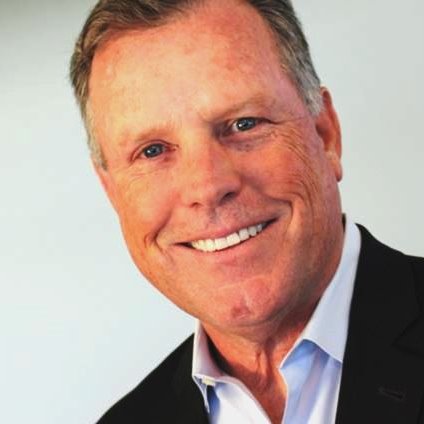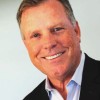
If you search the word “leadership” for books on Amazon, you will be presented with more than 191,000 choices. By any measure, that’s a lot of reading. Who’s buying all these books, and what’s the big deal? Why should we care about this stuff?
I have read a tiny fraction of these books. Even wrote one myself. I keep a few favorites close by on my own shelves. Some of the classics are a bit dog-eared from all the times I have returned to them for insights on how to deal with challenges in my personal and professional life, to be the best team member I can be, and to inspire the people in my organization to realize their full potential.
That’s the first notion I’d like to share about leadership: It’s not just about leading dozens or hundreds of people. It begins with you. You need to be in charge of your life and seek out environments and habits that help you thrive and grow before reaching out to lead others. In effect, your journey across the arc of leadership begins with how you seek to lead your life with joy and purpose and to pursue your professional dreams.
Research on the power of inspirational leadership from Bain & Company bears outs the idea that business executives must develop their own individual strengths before they can lead others. The Bain study identified 33 attributes of effective leaders in four general categories: developing inner resources (e.g., stress tolerance, emotional self-awareness, flexibility, optimism), connecting with others (e.g., vitality, humility, empathy, assertiveness), leading the team (e.g., vision, empowerment, harmony, servanthood), and setting the tone (e.g., worldview, openness, shared ambition, balance). The most important of all attributes, according to this study, is centeredness, defined as “a state of greater mindfulness, achieved by engaging all parts of the mind to be fully present.” The researchers note that “being centered is a precondition to using one’s leadership strengths effectively.” Beyond developing that attribute, exceptional leaders are those who develop and regularly display at least four distinguishing strengths, the study concludes.
[Link: http://www.bain.com/publications/articles/how-leaders-inspire-cracking-the-code.aspx]
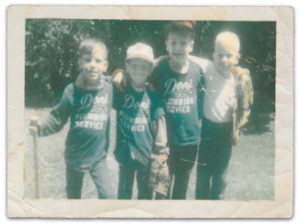 Next along the leadership arc is your role on a team. I have fond memories of joining my first team 50 years ago, playing baseball with my brother and Calvin and Howie from the neighborhood. I have so many fond and vivid memories from those days. I can still recall the excitement of getting a big hit or executing a great play and the disappointment at the end of a long summer evening when it got too dark to see the ball. That sense of connection in being part of a team has run throughout my life—all the way up to the executive team I’m working with now.
Next along the leadership arc is your role on a team. I have fond memories of joining my first team 50 years ago, playing baseball with my brother and Calvin and Howie from the neighborhood. I have so many fond and vivid memories from those days. I can still recall the excitement of getting a big hit or executing a great play and the disappointment at the end of a long summer evening when it got too dark to see the ball. That sense of connection in being part of a team has run throughout my life—all the way up to the executive team I’m working with now.
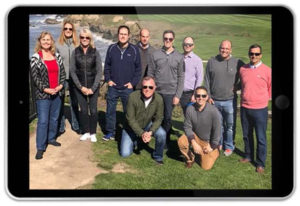 Here’s a photo of that team, the leaders of Partners Federal Credit Union. The striking thing to me about this group is that only 2 of the 11 people pictured here were on the executive team when I joined the credit union 13 years ago. Some people might hear that fact and think, “Uh oh, what’s wrong with this place that there’s so much change at the top?” But we think that kind of positive change is a key ingredient of our secret sauce.
Here’s a photo of that team, the leaders of Partners Federal Credit Union. The striking thing to me about this group is that only 2 of the 11 people pictured here were on the executive team when I joined the credit union 13 years ago. Some people might hear that fact and think, “Uh oh, what’s wrong with this place that there’s so much change at the top?” But we think that kind of positive change is a key ingredient of our secret sauce.
At Partners FCU, we encourage people to seek out opportunities for advancement, which also propels the organization forward. As the credit union’s leader, one of the my responsibilities that has the most impact on organizational performance is to promote the development of staff, managers, and executives by providing the resources and environment in which people can learn, grow, and realize their full capacity for achievement. At some point, the next step on the leadership arc for the people on my team is moving on to lead their own credit unions. Witnessing that progression makes me proud—and encourages others on our team to strive for the same path. All of that positive energy rolls up into something profoundly meaningful for each person in our company, for the credit union’s performance, and even for our wider industry.
I would submit that the role of leaders to encourage and empower people in their organizations to pursue professional advancement is especially critical given recent findings that the current generation of young people in the United States and other advanced nations could “end up poorer than their parents.” Far-reaching economic and societal factors and governmental policies well beyond the control of individual employers may be subverting the dream we share for our children—that they will have opportunities for better lives. But as business leaders, we can take steps to counteract that bleak outlook for our employees by championing their professional pursuits and contributions to the organization.
Full potential trajectory
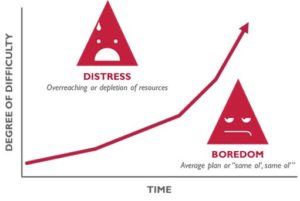 There is both science and art in charting the path to maximize the potential of the organization and the people within it. How much challenge can we take on at any one time? If we push too hard, the organization ends up in distress. Not hard enough, and we may succumb to lethargy and boredom. In achieving that optimal balance, we all need to work and progress together. No one set of individuals or department can be too far behind. Operations, Finance, or Marketing can’t lag because other departments rely on them to keep moving forward. We depend on each other to achieve our business plan. Another key responsibility for leaders is to work to ensure that all groups are thriving individually along the vertical axis in order to come back together and keep the organizational performance curve arcing upward.
There is both science and art in charting the path to maximize the potential of the organization and the people within it. How much challenge can we take on at any one time? If we push too hard, the organization ends up in distress. Not hard enough, and we may succumb to lethargy and boredom. In achieving that optimal balance, we all need to work and progress together. No one set of individuals or department can be too far behind. Operations, Finance, or Marketing can’t lag because other departments rely on them to keep moving forward. We depend on each other to achieve our business plan. Another key responsibility for leaders is to work to ensure that all groups are thriving individually along the vertical axis in order to come back together and keep the organizational performance curve arcing upward.
Maslow’s depiction of the journey
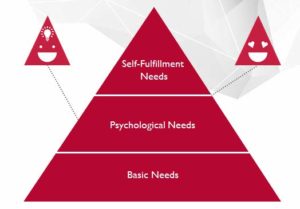 Abraham Maslow’s theories of individual progress through a hierarchy of human needs is extremely relevant to this dynamic, so it helps me in my journey of leadership to revisit his work. For a person to achieve self-fulfillment, he or she must integrate both the heart and the head, both thinking and passion. Maslow referred to this kind of fulfillment as self-actualization. To reach this level, people must take care of their own basic, psychological, and self-fulfillment needs and goals before they can give back to the community and help others thrive.
Abraham Maslow’s theories of individual progress through a hierarchy of human needs is extremely relevant to this dynamic, so it helps me in my journey of leadership to revisit his work. For a person to achieve self-fulfillment, he or she must integrate both the heart and the head, both thinking and passion. Maslow referred to this kind of fulfillment as self-actualization. To reach this level, people must take care of their own basic, psychological, and self-fulfillment needs and goals before they can give back to the community and help others thrive.
We all have these needs, whatever our backgrounds and beliefs and whether we were born into the boomer, Gen X, or millennial generations. It is helpful for leaders to keep these commonalities in mind. Being grounded in the realization that we’re all more alike than we’re different can help us figure out how best to lead a diverse organization.
Across the leadership continuum
Throughout the leadership literature, you can find a wide range of theories, frameworks, and depictions of organizational hierarchies. Dating back to the Industrial Age is the command-and-control model, a steep top-down approach in which the work is done by many led by a few. This model worked well in the era of assembly lines, where workers were considered interchangeable as they handled largely repetitive tasks. That just doesn’t fit the way many companies produce their products and services in our current knowledge economy, but there may still be an occasional role today for command-and-control. When a company is in crisis, for example, leaders may need to take more direct control to ensure the organization’s survival. That is, hopefully, a rare occurrence, but we can’t abandon this model once and for all.
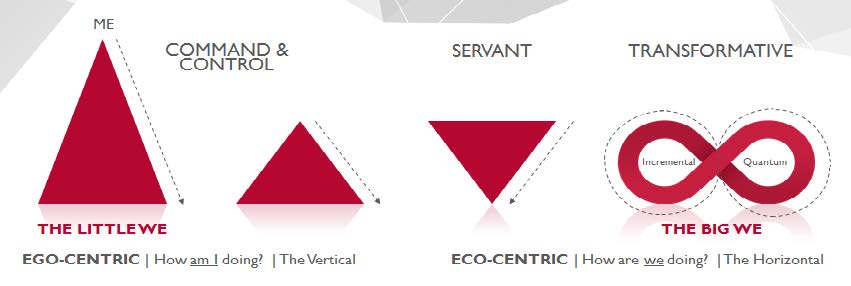 As business organizations evolved away from a model designed for industrial production, early attempts to rethink the command-and-control model focused on collapsing the hierarchy a bit by getting rid of the spans and layers of management in the middle. Many of us of a certain age went through those types of reorganizations, which were promoted in the name of efficiency. But we know now from decades of business research that those reorganizations didn’t really create much value. The aim was to get closer to members and clients, which was admirable, but some of those spans and layers served useful purposes for customers, and they’ve since been reimagined and reinserted into the organizational chart of many companies.
As business organizations evolved away from a model designed for industrial production, early attempts to rethink the command-and-control model focused on collapsing the hierarchy a bit by getting rid of the spans and layers of management in the middle. Many of us of a certain age went through those types of reorganizations, which were promoted in the name of efficiency. But we know now from decades of business research that those reorganizations didn’t really create much value. The aim was to get closer to members and clients, which was admirable, but some of those spans and layers served useful purposes for customers, and they’ve since been reimagined and reinserted into the organizational chart of many companies.
That brings us to another form of leadership, known as servant leadership, promoted chiefly by Steven Covey. The premise of this model is that leaders serve customers and staff, as evident in the title of another leadership book, Simon Sinek’s Leaders Eat Last. The philosophy behind this leadership model remains prevalent, but in the strictest form of a business organization, all the information goes up to the leader and the executive team so they can make the decisions and steer the ship. Thus, the structure of a hierarchy persists.
All of these models contribute to what’s been called transformative leadership, in which leaders must simultaneously address the daily work required to keep the company running but also the quantum challenges and opportunities facing the organization and business sector. In financial services, examples of current quantum issues include disruption in the mobile payments arena and the possibilities posed by block chain technology.
Communication doesn’t move in one direction in an organization that embraces transformative leadership. It moves in all directions to be effective. Leaders are listening to their customers, executive and management teams, frontline and back-office staff, vendors, and other stakeholders. They are monitoring what the competition is doing and what they can take away from other industries. And they must also be communicating plans for transformation clearly throughout the organization and involving managers and staff in those plans. A study by McKinsey & Company found that “a transformation’s success also requires that people across the organization have a specific role to play and that everyone knows how to carry out his or her part.”
In short, leaders adopting the transformative model are eco-centric, asking customers and staff “How are we doing?” But transformative leaders also keep the ego-centric approaches of command-and-control and other hierarchies in their tool belts, because these perspectives may still occasionally serve a purpose.
Model for today and the future
Applying all this talk about leadership models and business hierarchies, consider this: The traditional diagram of an organizational chart as a triangle is woefully inadequate. It doesn’t describe how we do business today. I’ve developed the accompanying schematic to depict how we incorporate both daily incremental progress with quantum advances. Business as usual, or incremental day-to-day progress, is shown on the left, and the quantum realm, where businesses innovate to get ahead, is on the right.
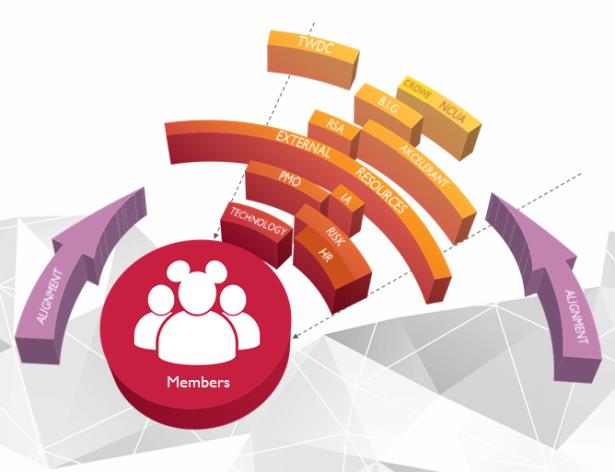 As this diagram illustrates, business leaders must be focused on what we’re doing today and what we need to be doing tomorrow. But we can’t handle all the demands of this dual focus on our own. We don’t have the bandwidth or, in all cases, the expertise to imagine and assess the possibilities before us. As a result, we need to use more strategic partnerships to get things done. Being able to move the pieces around to respond to different aspects of our mission and the continual evolution of the business environment is imperative. The combination of “just-in-time partnerships,” alongside the development of internal resources and expertise, helps fill the need for organizational agility.
As this diagram illustrates, business leaders must be focused on what we’re doing today and what we need to be doing tomorrow. But we can’t handle all the demands of this dual focus on our own. We don’t have the bandwidth or, in all cases, the expertise to imagine and assess the possibilities before us. As a result, we need to use more strategic partnerships to get things done. Being able to move the pieces around to respond to different aspects of our mission and the continual evolution of the business environment is imperative. The combination of “just-in-time partnerships,” alongside the development of internal resources and expertise, helps fill the need for organizational agility.
A visual metaphor for positioning all these components is aligning the tumblers in a lock to open your full potential. The synthesis of strong internal talent and top-notch external partners increases response time and reduces unhealthy stress on your people and organization. Whose job is it to monitor organizational agility and ensure that internal and external resources are aligned to climb the trajectory of full potential? This responsibility falls squarely on the CEO.
Me + We
In sum, a leadership approach in which leaders and all the members of their teams are encouraged and empowered to pursue their personal and professional dreams ultimately serves to boost organizational performance. A Better Me + A Better We offers a huge competitive advantage. Exponential gains are possible when employees are inspired and engaged and believe their jobs are important to the organization and themselves.
In parting, I’d like to suggest that we ask too little of CEOs and leaders today. Business success is not just about earnings per quarter, but about developing your people power as well. Helping staff achieve upward mobility professionally and personally entails a commitment to a disciplined approach of pursuing results and relationships simultaneously. One without the other reduces performance. At Partners Federal Credit Union, we made a commitment initially to focus on leadership development. Based on the positive results we saw from that investment in developing internal leadership talent, we next offered professional development opportunities to our 60 management staff—and this year, we will roll out training for all 400 employees to empower them to take charge of their professional futures. We believe in our employees, and we expect this investment in their development will yield big gains for the organization as well.

